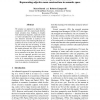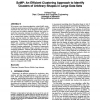5659 search results - page 123 / 1132 » Comparing Clusterings in Space |
CCECE
2006
IEEE
14 years 4 months ago
2006
IEEE
Multiuser detection (MUD) techniques are known to improve the performance of CDMA cellular communication systems. This performance improvement usually comes at a large computation...
EMNLP
2010
13 years 8 months ago
2010
We propose an approach to adjective-noun composition (AN) for corpus-based distributional semantics that, building on insights from theoretical linguistics, represents nouns as ve...
NAACL
2010
13 years 8 months ago
2010
Current vector-space models of lexical semantics create a single "prototype" vector to represent the meaning of a word. However, due to lexical ambiguity, encoding word ...
DMIN
2006
13 years 11 months ago
2006
Medical data is often presented as free text in the form of medical reports. Such documents contain important information about patients, disease progression and management, but ar...
KDD
2002
ACM
14 years 10 months ago
2002
ACM
We propose a new clustering algorithm, called SyMP, which is based on synchronization of pulse-coupled oscillators. SyMP represents each data point by an Integrate-and-Fire oscill...


